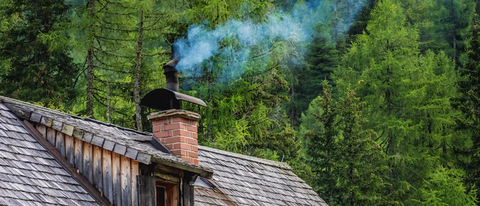Before choosing which fuel type is best for your home, understanding the different ventilation requirements among wood, pellet and gas stoves is essential. In this blog post, we will cover the venting requirements for each, plus how to maintain your venting annually.
How Does Venting Work?
Wood, pellet and gas appliances all require venting, which removes fumes and byproducts, such as carbon monoxide, nitrogen dioxide and excess moisture, keeping the air you breathe safe and healthy. Wood, pellet and gas appliances are all vented differently to accommodate the unique ways they operate.
Wood Stove Venting
To properly vent a wood stove, a Class A chimney is required and a fresh air intake is strongly recommended. Class A chimneys are made of a stainless steel interior and a stainless steel exterior, with either insulation or an air channel in between the outer and inner wall. You will use this when venting through a wall or the ceiling all the way to the roof or above the roof line. If possible, it is preferred to run the venting vertically through the roof of your home. By venting vertically through a roof, the inside of the venting will stay warmer and draft more efficiently. Typically, this type of installation costs less as well.
You’ll start by connecting single or double wall interior stove pipe to the top of your stove. That pipe will run from your stove and connect to the Class A chimney which then goes through the ceiling or wall. In many cases, a double wall pipe is preferred because it reduces clearances. However, for this reason, it tends to be more costly compared to a single wall pipe.
Pellet Stove and Insert Venting
Similar to wood stoves or inserts, pellet stoves require a pipe specifically designed to handle the heat and byproducts of burning pellets. While fresh air intake is not required on all pellet appliance installations, it is strongly recommended to use a fresh air intake to pull air for combustion from outside is more efficient, doesn’t use the warm indoor air and keeps the oxygen levels intact. The venting of your pellet stove safely expels all the byproducts of combustion to the outside of your home. For stoves, this is a ridged vent and for inserts, it is typically a flexible vent.
Pellet stoves can vent horizontally through an outside wall or vertically through the roof, providing more installation options for different areas of your home. It is always recommended to get at least 48” of vertical pipe before a horizontal termination. This will help your stove draft better in cases of power outages.
Gas Stove and Insert Venting
Gas stoves use direct vent technology, a sealed system that uses outside air for combustion. Direct venting removes 100% of combustion exhaust and fumes from your home using a sealed system, providing optimal heating while conserving energy. Gas stove venting can be installed vertically through the roof or horizontally through a outside wall, making it possible to add a gas stove to almost any room. Gas inserts required a flexible vent so it can easily snake its way through your existing wood chimney.
To learn more about direct vent technology, watch this video.
What Maintenance Does Venting Require?
Wood Stoves
It is best practice to inspect your wood stove’s chimney yearly to prevent pipe blockage, poor draft quality and even chimney fires. You can choose to inspect your chimney yourself by inspecting your chimney from the rooftop by looking for excess build-up (glossy sheen on the inside of the pipe) or the interior size of your pipe shrinking. In most cases, even if you can't see much, you should still clean your chimney before each season.
You can do this yourself if you choose by purchasing a specific chimney clearing brush and flexible extension rods that attach to the brush and allow you to push all the debris down into a bag that you have hanging from the pipe you disconnected from your stove. However, we recommend hiring a professional to perform a yearly chimney inspection and sweep to look for cracks, leaks, warping and any obstructions that could lead to a chimney fire or carbon monoxide leak.
Pellet Stoves
In most cases, your owner's manual will include instructions for inspecting the health of the chimney. But just like a wood stove, inspecting and cleaning the chimney prior to each season is your best bet. Remember, while clearing out the flue, use a flue brush and be careful not to go in too far, as this can damage your exhaust sensing probe if your stove has one. We recommend contacting your local dealer if you need clarification about maintaining your flue.
Gas Stoves
Even though gas stoves don’t produce creosote, we recommend inspecting the venting for any damage or animal nests that may have been built during the summer. You can do this by removing the cap on the outside of the house and visually inspecting the venting, However, be sure to put it back correctly and replace any sealant used to keep the water out. Otherwise, we recommend contacting your local gas professional to take care of that for you.

Next Steps
Proper venting and maintenance ensure the health and safety of all who enjoy the glowing warmth from your stove or insert. If you have additional questions about venting, maintenance and installation, our team of expert Vermont Castings, Harman and Quadra-Fire dealers are here to help with every step of the way.


